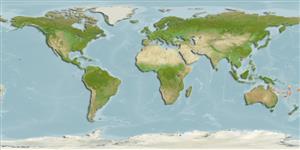Environment: milieu / climate zone / depth range / distribution range
Ecologia
marino batidemersale; distribuzione batimetrica 300 - 360 m (Ref. 13707). Deep-water
Distribuzione
Stati | Aree FAO | Ecosystems | Presenze | Point map | Introduzioni | Faunafri
Western Pacific: Kyushu-Palau Ridge and New Caledonia; probably widespread in the area.
Size / Peso / Age
Maturity: Lm ? range ? - ? cm
Spine dorsali (totale) : 3; Raggi dorsali molli (totale) : 13 - 15; Raggi anali molli: 13 - 14. Body with short ocellate lines and blotches. Each anal fin membrane with a dark spot (Ref 42912).
Life cycle and mating behavior
Maturità | Riproduzione | Deposizione | Uova | Fecundity | Larve
Fricke, R., 1992. Revision of the family Draconettidae (Teleostei), with descriptions of two new species and a new subspecies. J. Nat. Hist. 26(1):165-195. (Ref. 13707)
IUCN Red List Status (Ref. 130435: Version 2024-1)
Threat to humans
Harmless
Human uses
Strumenti
Special reports
Download XML
Fonti Internet
Estimates based on models
Phylogenetic diversity index (Ref.
82804): PD
50 = 0.5001 [Uniqueness, from 0.5 = low to 2.0 = high].
Bayesian length-weight: a=0.00389 (0.00180 - 0.00842), b=3.12 (2.94 - 3.30), in cm total length, based on all LWR estimates for this body shape (Ref.
93245).
Trophic level (Ref.
69278): 3.3 ±0.5 se; based on size and trophs of closest relatives
Fishing Vulnerability (Ref.
59153): Low vulnerability (10 of 100).
